Come join us now, and enjoy playing your beloved music and browse through great scores of every level and styles!
Can’t find the songbook you’re looking for? Please, email us at: sheetmusiclibrarypdf@gmail.com We’d like to help you!
The Harmony of Bill Evans (3a) “TIME REMEMBERED“ – HARMONIC ANALYSIS (with sheet music)
“Time Remembered” must have emerged from very deep within the musical mind of Bill Evans or, as he might have put it, from the “universal mind.” It is a composition that harmonically pays homage to the Modal period in music history, the sixteenth century that gave birth to Palestrina, Byrd, Caccini, Morley, Monteverdi, Frescobaldi, and Schutz.
The harmonies and progressions of “Time Remembered” suggest four modes or scales that formed the basis of many of the works of that period: the Dorian, Phrygian, Lydian, and Aeolian.
The Bach chorales of the seventeenth century mark the transition from Modality to Tonality (major/minor system). We then had to wait three hundred years for a reincarnation of the modes in the compositions of Debussy and Ravel.
Bill knew these two Impressionistic masters inside and out, and in “Time Remembered,” he has compressed within 26 measures four hundred years of musical evolution from Modality to Tonality to Impressionism.
The unique thing about “Time Remembered” is the inconspicuous absence of the dominant 7th chord and its derivatives, the half-diminished and the full-diminished. When Bill had eliminated these, he was left with only major and minor chords. For this reason, the piece sounds impressionistic and modal.
He has met the challenge of writing a tune with only two harmonic qualities by introducing unusual root movements and by exploiting the use of the upper partials (9, 11, 13) in the melody.
Let’s look at EX. 1 in which I have reduced the original to four parts. The root is always in the bass” The 3rd, 5th, and 7th, however, are voiced in a variety of ways, according to the new voicing categories that I will explain shortly.
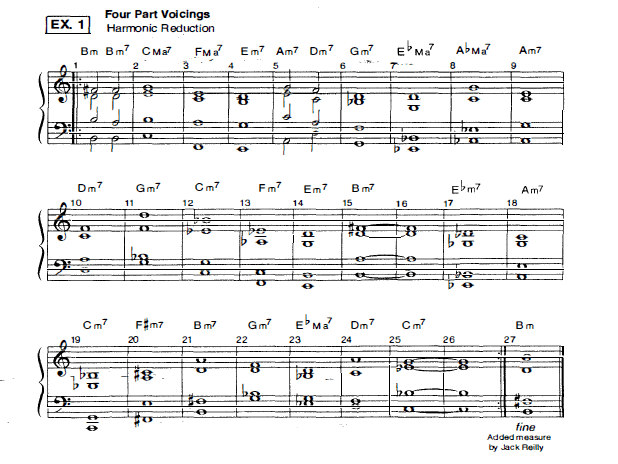
The original Bill Evans score of “Time Remembered” (EX. 2) is one of Bill’s most complex contrapuntal scores-. It’s equal in difficulfy to Bach’s Five-Part Fugue in C-sharp from Book One of the Well-Tempered Clavier.
To help you to achieve a better legato, I have written a set of fingerings. Also, you might have a look at the Fugue. It’s a good preparatory piece for “Time Remembered.”.
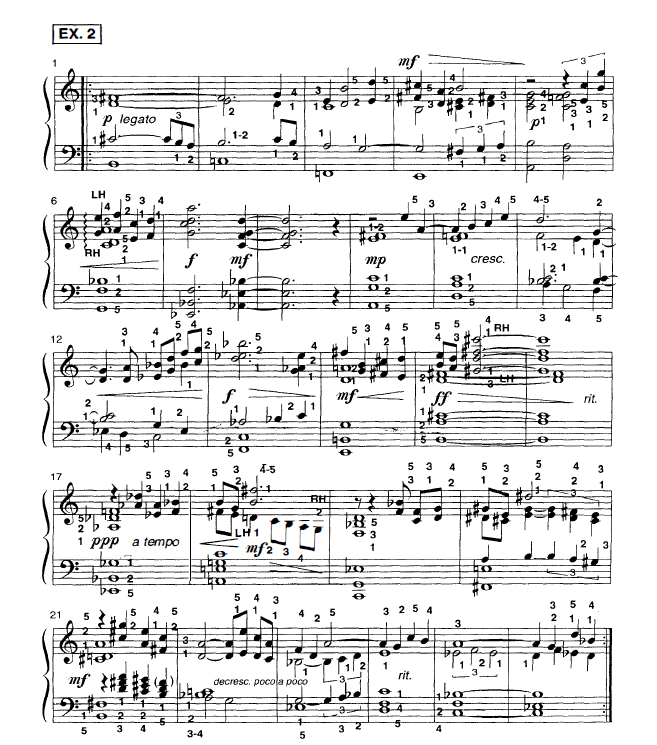
Now look at EX. 1 and listen for the harmonic qualities of Ma7 or m7; observe the voicings; feel them in your hands. Now visualize the 5th omitted. What’s left? The root, 3rd, and 7th, of course: the three-note concept. By adding the 5th to all the chords in “Time Remembered,” Bill has quadrupled the voicing possibilities.
He has also created five new voicing categories. The voicings in measures 1, 2, 6, 9, 15, 25, 26, and 29, I call category” A”: the root, 7th, 3rd, and 5th. In measures 5 (third beat only), 10 and 18, the voicing is root, 5th, 7th, and 3rd. Let’s call this category “B.”
In measures 7, 8, 12, 13, 14, 17, 19, and 21, Bill voices the chords root, 5th, 3rd, and 7th. We’ll name these the “C” voicings. Next we read root, 3rd, 7th, and 5th in measures 11 and 24. This will be the “D” voicing category. Lastly, in measures 3, 4, 5 (first beat only), 22, and 23, Bill uses block voicings. This makes up our fifth category, the “E” voicings.
To make it easier to follow this analysis, I have rewritten and organized EX. 1 by voicing categories. Refer now to EX. 3A, 3B, 3C, 3D, and 3E (bar numbers under EX. 3A-3E indicate which measure(s) contains the voicing category. For example, bars 1 & 15 are examples of” A” voicings, etc.).
I have also written out all inversions appropriate to each voicing category. Exhaust all possibilities! That’s my motto. Bill did. He spent hours and hours practicing these fundamental four-part voicings, in every category, in root position and all inversions, and in all keys, until they were “second nature.”
Nobody else since Art Tatum has had such an enormous voicing vocabulary “in the fingers.” And Bill has surpassed Tatum in this department owing to his broader knowledge of classical music, especially the music of Debussy, Ravel, and Stravinsky.
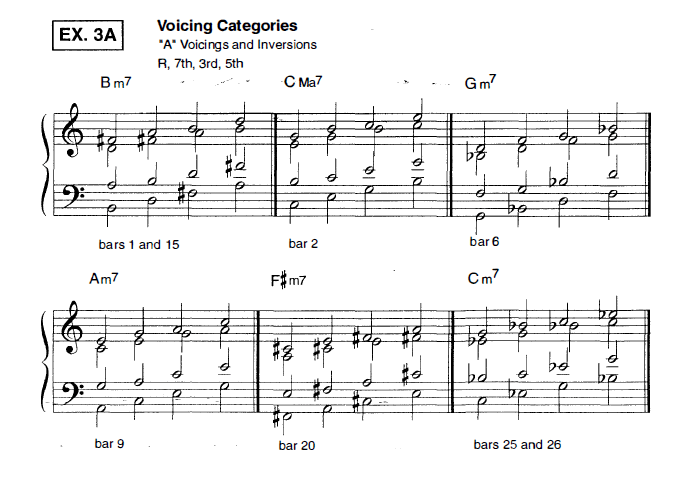
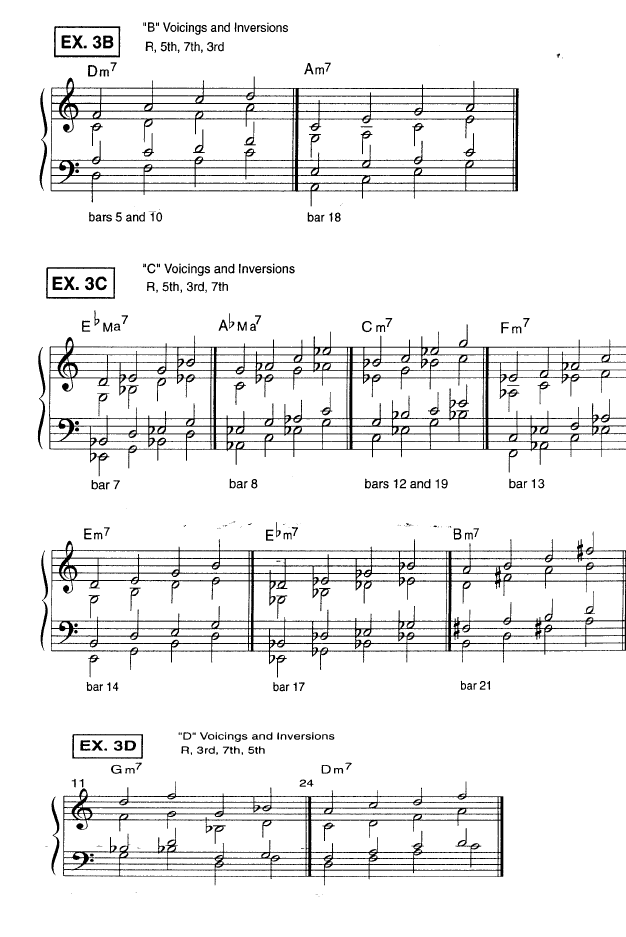
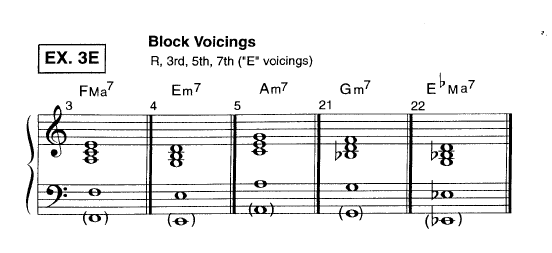
Now I will analyze in detail measures 7 and 8 from the original score. See EX. 4. Bill has written an Eb Ma13th resolving up a fourth to Ab Ma13th. Can you see the basic four-part seventh chord voicings and categories hidden in these seven-part chords? Not yet? Then look at EX. 4A.
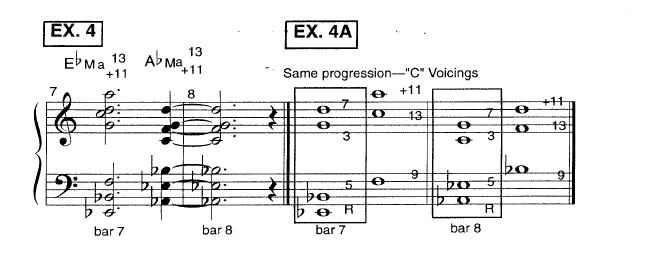
Here I have isolated the basic four parts from the upper partials. (This is what the harmonic reduction in EX. 1 is all about). It is now clear that both chords belong to the “C” voicing category (See EX. 3C). Separated in EX. 4A, the upper partials now look like major triads.
But they also-belong to the Eb and Ab Ma7 chords as the 9th,+ 11th, and 13th. Here’s a simple rule to follow: by visualizing major triads superimposed one whole step above Major7ths, you will learn to play seven-part Major13th chords quickly. Such practice is also the first step toward thinking in polytonal relationships.
Now look at EX. 5, SA, and SB. In these examples, I have placed the upper partials of the EbMa13th with the inversions.
Further experimentation will reveal other possibilities. Then you can do what Bill did: at the piano transpose your experiments to all keys until they are “in the fingers.”
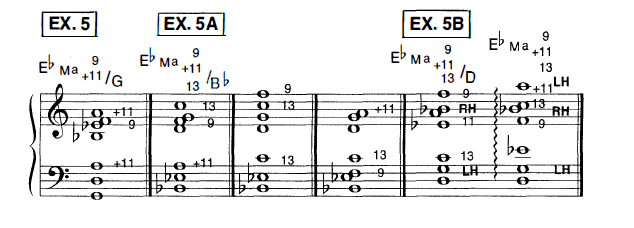
In EX. 6 and 6A, my analysis of measure 6 from Bill’s original score (see EX. 2) follows the same procedure as in EX. 4 through SB. Only this time I have chosen the minor chord quality, which in this measure is a Gm13th.
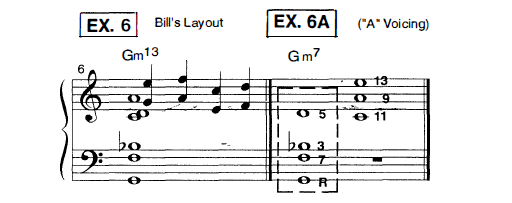
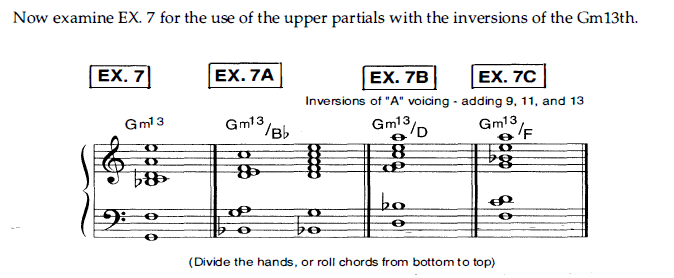
Analyze each measure of Bill’s score similarly, and you’ll complete the harmonic picture of “Time Remembered” By a careful study of all the chord categories in this article, you will now have a method by which to work out the analysis of all Bill’s original scores on your own. Continue to experiment with all the chord categories from EX. 3A through 3E by placing the 9th,+ 11th, and 13th within the voicing of the basic four-part 7th chords that I have written out for you in these examples.
In the final example (EX. 8), I have written a seven-part voicing arrangement of “Time Remembered” based on all the principles discussed above and in the “Peri’s Scope” articles. Examine each measure and try to separate the basic four-part voicing by writing it next to my seven-part realization. Analyze the chord voicing category. I have worked out the first three measures for you (EX. 8, measures 1- 3).
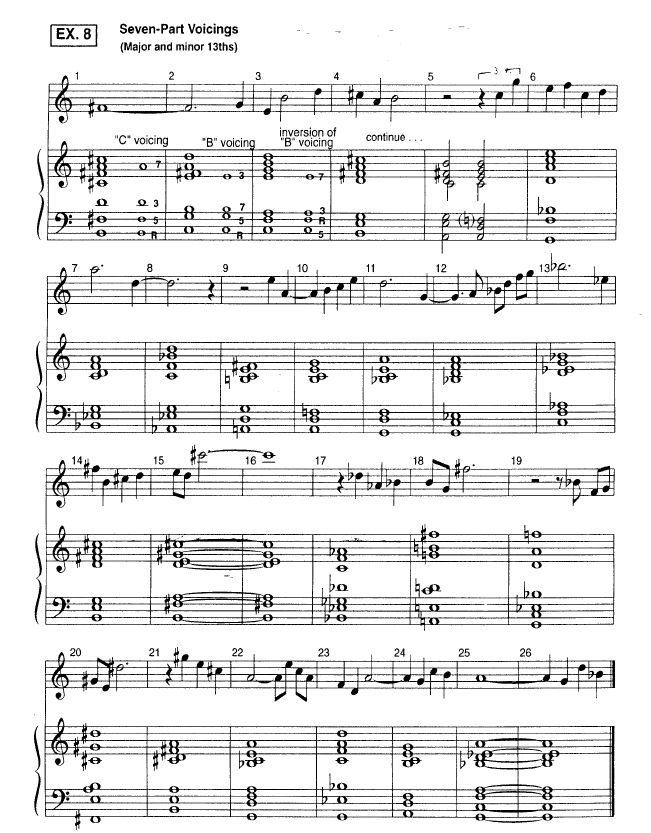
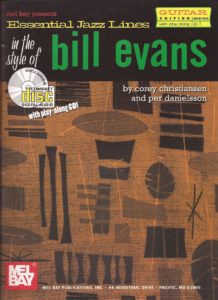
Browse in the Library:
Or browse in the categories menus & download the Library Catalog PDF:
